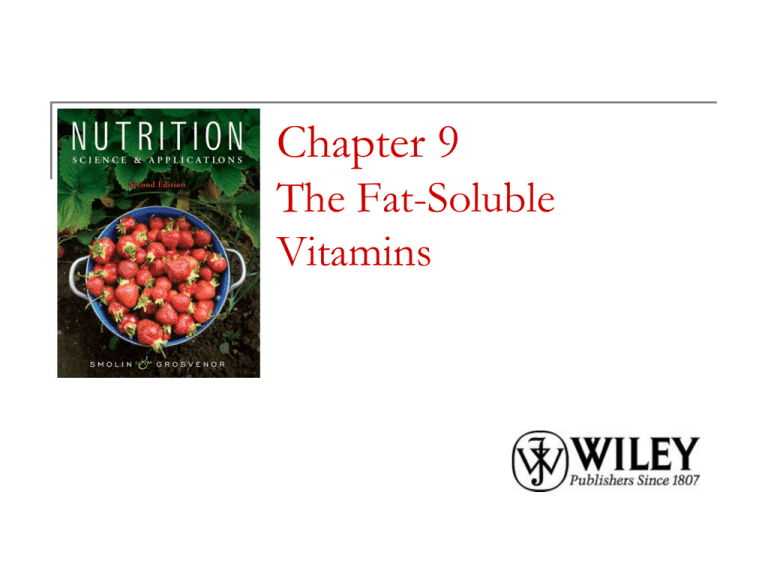
Chapter 9
The Fat-Soluble
Vitamins
Fat-Soluble Vitamins
Vitamins A, D, E and K are fat-soluble vitamins.
Fat-soluble vitamins require bile and dietary fat for
absorption.
Once absorbed, they are transported with fats
through the lymphatic system in chylomicrons
before entering the blood.
Fat-soluble vitamins can be stored in body fat,
meaning that intakes can vary without a risk of
deficiency (as long as there are average intakes
over time).
Because they can be stored in body fat, fat-soluble
vitamins are not easily excreted. This increases the
risk of toxicity with high intakes.
Copyright 2010, John Wiley & Sons, Inc.
Absorption
of Vitamins
Copyright 2010, John Wiley & Sons, Inc.
Fat soluble vitamins require _____ and _____ for
absorption into the mucosal cell.
a) bile and lymph
b) lymph and dietary fat
c) lymph and chylomicrons
d) bile and dietary fat
Copyright 2010, John Wiley & Sons, Inc.
Since vitamin A and
carotenoids are bound to
proteins in foods, ______
is necessary to release
them for absorption.
Pepsin
Bile
Amylase
Lactase
Copyright 2010, John Wiley & Sons, Inc.
Vitamin A
Vitamin A is found preformed, from animal
products or supplements, or in precursor form,
from plant foods, in the diet.
Vitamin A plays a key role in
night vision
cell differentiation
growth regulation.
Copyright 2010, John Wiley & Sons, Inc.
Vitamin A
Preformed vitamin A compounds are known as
retinoids.
In the diet, preformed Vit A is present as retinol bound
to fatty acids. retinOl and retinAl are interconverted
in the body.
Plants contain precursors to vitamin A known as
carotenoids. Carotenoids can be converted into
retinal in the intestinal mucosa and the liver. B
carotene is not as well absorbed as preformed Vit A
(about 12 mg dietary B carotene yeild 1 mg
retinol).
Copyright 2010, John Wiley & Sons, Inc.
The carotenoid with the
most vitamin A activity is
_____.
a)
Beta-carotene
b)
Zeaxanthin
c)
Lutein
d)
Lycopene
Copyright 2010, John Wiley & Sons, Inc.
Vitamin A in the Diet
Copyright 2010, John Wiley & Sons, Inc.
Beta-carotene is least
plentiful in which food?
yellow squash
spinach
yellow apples
carrots
Copyright 2010, John Wiley & Sons, Inc.
hypercarotenemia
Large intake of carotenoids. Not toxic as the conversion to
retinoids is limited. Caused by excess carotenoids stored in
adipose tissue.
http://www.dermnetnz.org/systemic/img/carot-s.jpg
Copyright 2010, John Wiley & Sons, Inc.
Vitamin A and the Visual Cycle
Copyright 2010, John Wiley & Sons, Inc.
Keratomalacia from vit A deficiency
http://webeye.ophth.uiowa.edu/eyeforum/atlas/photos/8healed-keratomalacia-with-buphthalmos.jpg
Copyright 2010, John Wiley & Sons, Inc.
Vitamin A is stable
except when exposed to:
a)
heat
b)
light
c)
lack of oxygen
d)
fat
Copyright 2010, John Wiley & Sons, Inc.
Which form of vitamin A is
involved in vision?
carotenoids
preformed vitamin A
retinal
retinoic acid
Copyright 2010, John Wiley & Sons, Inc.
Vitamin A and Gene Expression
Copyright 2010, John Wiley & Sons, Inc.
Cell differentiation, or the
process by which a cell
becomes more specialized, is
most affected by which form
of vitamin A?
a)
preformed vitamin A
b)
c)
d)
retinal
retinoic acid
retinol
Copyright 2010, John Wiley & Sons, Inc.
Vitamin A Deficiency and Toxicity
Vitamin A deficiency is a threat to the health,
sight and lives of millions of children around the
world.
Vitamin A deficiency can be caused by
insufficient intake of vitamin A, fat, protein or zinc.
Preformed vitamin A can be toxic if taken in high
amounts.
Medications made from vitamin A, such as Retin
A or Accutane, can cause serious side effects.
Copyright 2010, John Wiley & Sons, Inc.
Vitamin D
Vitamin D is known as the “sunshine vitamin”
because it can be produced in the skin by exposure
to UV light.
Only a few foods are natural sources of Vitamin D,
including liver, fatty fish, fish oils and egg yolks.
Vitamin D can be toxic at high levels, so there are
strict limitations on the categories of foods that can
be vitamin D-fortified.
Copyright 2010, John Wiley & Sons, Inc.
Vitamin D's primary function
in the body is to
a)
prevent anemia
b)
regulate calcium and
phosphorus levels
c)
regulate iron levels in
the body
d)
support night vision
Copyright 2010, John Wiley & Sons, Inc.
Vitamin D
Vitamin D is important for
bone health
normal functioning of the parathyroid gland
regulation of the immune system.
Copyright 2010, John Wiley & Sons, Inc.
Vitamin D Deficiency and Toxicity
When vitamin D is deficient, dietary calcium cannot be
absorbed efficiently and there can be improper bone
mineralization and abnormalities in bone structure.
In children, vitamin D deficiency can result in rickets; in
adults, osteomalacia.
Oversupplementation of vitamin D can result in high
blood and urine calcium concentrations, depositing of
calcium in blood vessels and kidneys, cardiovascular
damage and possibly death.
Copyright 2010, John Wiley & Sons, Inc.
Vitamin D
Rickets is a
syndrome
characterized by
bone deformities in
children, and caused
by vitamin D
deficiency.
Copyright 2010, John Wiley & Sons, Inc.
Osteomalacia
A vitamin D deficiency
disease in adults
which is characterized
by weak (principally
affects bone
remodeling
Low vitamin D levels have been found in 8% of women living in
nursing homes, 6% of young women, and 1.6% of elderly people
living in the community in Omaha, Nebraska
For people of south Asian (Indian subcontinent) descent living in
the UK, 56% of elderly and 41% of the young have been found to
have significantly lower levels of vitamin D than Caucasian
controls.
Copyright 2010, John Wiley & Sons, Inc.
May coexist with osteopersosis
African Americans are at increased risk of
vitamin D deficiency for all of the following
reasons except:
Darkly pigmented skin filters
out more light.
They spend less time in the sun
than people of other ethnic
origins.
Milk consumption is low.
Lactose intolerance is common.
Copyright 2010, John Wiley & Sons, Inc.
Vitamin D in the Diet
Copyright 2010, John Wiley & Sons, Inc.
Vit D
What macronutrient is the base for Vit
D?
Copyright 2010, John Wiley & Sons, Inc.
Vitamin D
from UV
Light or the
Diet
Cholecalciferol is a
form of vitamin D, also
called vitamin D3 or
calciol. It is the
unhydroxilated form of
Vit D, formed right after
7-dehydrocholesterol is
struck by light
Copyright 2010, John Wiley & Sons, Inc.
Vitamin E
Idenetified as the fat soluble component of grains
important for fertility.
Vitamin E is also called tocopherol. (Greek tos:
childbirth and phero: to bring forth)
Vitamin E has antioxidant properties.
Alpha-tocopherol is the form of vitamin E absorbed by
the human body. The other forms cannot be
distrubuted. The supplement form contains 8 different
isomers, only ½ of which are active in the body.
Vitamin E absorption depends on normal fat absorption.
Once absorbed, vitamin E is incorporated into
chylomicrons.
Copyright 2010, John Wiley & Sons, Inc.
Converting Vit E units (pg 403)
To estimate alpha tocopherol in foods
If values are given as mg alpha-Tes
1.
1.
Mg x0.8= mg alpha tocopherol
If values given in IUs
2.
1.
2.
3.
First determine if the source is synthetic or natural
IU natural alpha tocopherol x 0.67=mg alpha
tocopherol
IU synthetic x0.47= mg alpha tocopherol
Copyright 2010, John Wiley & Sons, Inc.
Vit E
Roles of vitamin E?
Antioxidant
maintains the integrity of cell membranes
Preserves lipids such as LDL and PUFAs
Red Blood Cell: Vitamin E deficiency in newborns might
result in hemolytic anemia.
Lung cells
Nervous system cells
protects against some environmental pollutants.
Heavy metals (lead, mercury), toxins (carbon
tetrachloride, benzene), pollutants (ozone).
Copyright 2010, John Wiley & Sons, Inc.
In the liver, vitamin E is
incorporated into _____ and from
there distributed to other
lipoproteins and delivered to
cells.
Chylomicrons
VLDL
LDL
HDL
Copyright 2010, John Wiley & Sons, Inc.
Vitamin E in the Diet
Copyright 2010, John Wiley & Sons, Inc.
Which is NOT considered a good
source of vitamin E?
a)
peanuts
b)
soybean oil
c)
fortified breakfast cereals
d)
orange and yellow
vegetables
Copyright 2010, John Wiley & Sons, Inc.
Vitamin E is an Antioxidant
Copyright 2010, John Wiley & Sons, Inc.
Vitamin K
Vitamin K was named for koagulation, the
Danish word for coagulation.
Vitamin K is found in several forms,
including phylloquinone and
menaquinones.
Abnormal blood coagulation is the major
symptom of vitamin K deficiency.
Vitamin K deficiency is very rare in the US.
Copyright 2010, John Wiley & Sons, Inc.
Vitamin K in the Diet
Copyright 2010, John Wiley & Sons, Inc.
A Summary of the Fat-Soluble Vitamins
Copyright 2010, John Wiley & Sons, Inc.
Vitamin A toxicity occurs most frequently
when large amounts of _________ is (are)
ingested.
a)
b)
c)
carrot juice
egg yolks
polar bear liver
d)
vitamin A supplements
Copyright 2010, John Wiley & Sons, Inc.
A Summary of the Fat-Soluble Vitamins
Copyright 2010, John Wiley & Sons, Inc.
The recommended intake
of vitamin E is expressed
in:
a)
b)
c)
REs
µg
alpha-tocopherol
equivalents
d)
mg alphatocopherol
Copyright 2010, John Wiley & Sons, Inc.
Benefits and Risks of Fat-Soluble
Vitamin Supplements
Copyright 2010, John Wiley & Sons, Inc.
Trends in the modern diet have
reduced the consumption of fruits
and vegetables. This has reduced our
intake of all of the following except
vitamin ____.
A
D
E
K
Copyright 2010, John Wiley & Sons, Inc.
A deficiency of vitamin A
can result in
a)
beriberi
b)
goiter
c)
scurvy
d)
xerophthalmia
Copyright 2010, John Wiley & Sons, Inc.
Which of the fat soluble
vitamins can be synthesized by
bacteria in the intestine?
a)
vitamin A
b)
vitamin D
c)
vitamin E
d)
vitamin K
Copyright 2010, John Wiley & Sons, Inc.
Long term use of antibiotics may result in vitamin K
deficiency because:
a)
antibiotics may interfere with
absorption of the vitamin
b)
antibiotics use vitamin K to function
properly
c)
antibiotics may change the bacterial
flora in the gut, decreasing vitamin K
production
d)
antibiotics may promote other
vitamins which compete with vitamin
K for absorptionc
Copyright 2010, John Wiley & Sons, Inc.
Vitamin E's primary function in
the body is:
a)
b)
to act as an
antioxidant
to increase absorption
of calcium in the small
intestine
c)
to regulate acid-base
balance
d)
to regulate phosphorus
levels
Copyright 2010, John Wiley & Sons, Inc.
Chapter 9
Copyright 2010 John Wiley & Sons, Inc.
All rights reserved. Reproduction or translation of this work beyond
that permitted in section 117 of the 1976 United States Copyright Act
without express permission of the copyright owner is unlawful.
Request for further information should
be addressed to the
.
Permissions Department, John Wiley & Sons, Inc. The purchaser may
make back-up copies for his/her own use only and not for distribution
or resale. The Publisher assumes no responsibility for errors,
omissions, or damages caused by the use of these programs or from
the use of the information herein.
Copyright 2010, John Wiley & Sons, Inc.







